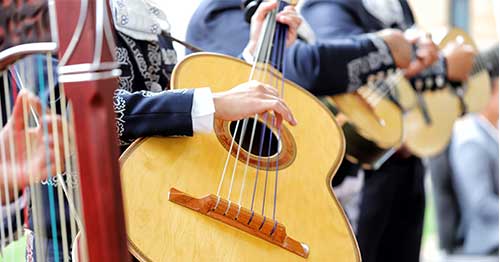5 Ways to Teach Students About Juneteenth
by Connections Academy
byConnections Academy
6 min to readSeptember marks the beginning of Hispanic Heritage Month, and over the years, you’ve likely heard people use terms like Hispanic, Latino, and Spanish to describe themselves. As for Hispanic and Latino, those terms are often used interchangeably. And although a common practice, there are unique differences between the two cultures.
Whether you’re wondering about the difference between Hispanic and Latino terminology or your child has questions about the respective heritages, it’s important to be educated on each culture this month and beyond.
Before addressing the terms Latino versus Hispanic, it’s helpful to learn how Hispanic Heritage Month came about.
Hispanic Heritage Month’s origins date back to 1968. The observation started as Hispanic Heritage Week under President Lyndon Johnson and was expanded by President Ronald Reagan in 1989 to cover 30 days. Since 1989, Americans have observed Hispanic Heritage Month from September 15 to October 15 to celebrate the contributions of American citizens whose ancestors came from Spain, Mexico, the Caribbean, and Central and South America.
What’s significant about September 15 is that in 1851, five Latin American countries—Costa Rica, El Salvador, Guatemala, Honduras, and Nicaragua—earned their independence. In addition, Mexico and Chile celebrate their independence days on September 16 and September 18, making for a month filled with history and culture.
Now that you have a baseline knowledge of Hispanic Heritage Month, you’re probably wondering: What’s the difference between Latino and Hispanic? Is Hispanic a race? What makes someone Latino? The terms Hispanic and Latino should be used when describing a person’s identity. It’s best to be respectful and never ask someone about their ethnicity unless they bring it up. Due to the cultural diversity of Latin America and the richness of Hispanic culture, it’s important to allow each person to express what label they give themselves. Here are a few descriptors:
The term Hispanic refers to people who speak Spanish or those who have descended from a Spanish-speaking country. Although Hispanic people often share cultural similarities, that doesn’t mean that they’re the same race. In fact, the term Hispanic doesn’t refer to race at all. It refers to shared ethnicity and identity. For example, a person from Puerto Rico and a person from Mexico might both call themselves Hispanic because they share a common cultural component like language, but ultimately identify as two different races.
Additionally, the definition of Hispanic excludes Brazil because Portuguese is the country’s primary language.
The big question is: Are Brazilians Latino? Yes, they are. Why? Because the country is located in Latin America. Similar to the term Hispanic, Latino doesn’t refer to race, but geography. People from Latin America, including Central America, South America, and the Caribbean, identify with this term, bringing different Latin cultures and customs along with them.
To help your K-12 student better understand, think of Brazil as the distinguisher between the two. Every time they have a question, remind them that Brazilians are Latin American but aren’t considered Hispanic because their primary language is Portuguese! Among the vast cultural traits of Latin America, this simple fact can help them easily distinguish the cultures.

Hispanic heritage and culture in Latin America are full of rich history that should be celebrated! Here are some activities you can do with your child to help them learn about Hispanic and Latino heritage.
Music is incredibly important in Hispanic and Latino culture. From the salsa to the merengue, rhythmic tones are often incorporated into every song. To help your online student increase their knowledge around Hispanic Heritage Month, you might consider playing music between lessons. This is a fun and educational way for them to become familiar with the Spanish language and be exposed to the culture.
You can use your favorite music streaming service to search for kids songs and playlists by Hispanic and Latino artists. You can also do an internet search for traditional Latin dances mentioned above. And listening to music might even benefit your child’s day-to-day learning! Background music has helped some students with memorization and can help your child grasp new knowledge more easily.
For older online school students, introduce research projects. Whether using books or media, there’s much for them to discover. For instance, you can prompt your student to select a notable Hispanic or Latino person to learn facts about. As they’re learning about the person, they’re also being immersed in the culture. To keep them on track with their project, you could set up a “share time” at dinner when your student discusses the information they’ve learned that day.
When celebrating Hispanic Heritage Month with younger students, crafts can be a great option. At the end of the day or during lunch break, take out crayons and construction paper to prepare for a hands-on learning activity. Help them research a Spanish-speaking or Latin American country to focus on for their crafts session. Then, based on that decision, they can create things like a homemade piñata, paper fiesta flowers, or cardboard maracas. Here are some kid-friendly craft projects to consider.
Books can paint a beautiful picture of Hispanic and Latino culture. Take a trip to your local library to pick up literature featuring Hispanic and Latino characters, artists, or authors. In addition, parents can join in on the fun and read Spanish-language or bilingual books with their children to help encourage their learning.
Encourage your student to identify a Spanish-speaking or Latin country that they’d like to study. For elementary and middle schoolers, you can challenge them to a geography scavenger hunt where they learn interesting facts about their selected country. Through this activity, they work on their geography, map skills, and world history. Students in online high school can be tasked with studying geography textbooks and analyzing the migration and impact of Hispanic and Latino people. This is a great way to honor and learn about their contributions.
Scan your community listings for a museum, exhibit, or cultural event near you. For example, Google Arts & Culture has a wonderful section dedicated to Latino Cultures in the U.S. There you can find online exhibits and virtual tours of historic Hispanic heritage sites. Across the community, Hispanic Heritage Month festivals and parades are likely to be occurring too. While attending, you and your child can experience the joy and delight of tradition.
Both Hispanic and Latin American culture are rich in tradition, vibrancy, and history. Even if you don’t consider yourself Hispanic or Latino, you can still seize the opportunity to learn more about the cultures during Hispanic Heritage Month.
Both Hispanic and Latin American culture are rich in tradition, vibrancy, and history. Even if you don’t consider yourself Hispanic or Latino, you can still seize the opportunity to learn more about the cultures during Hispanic Heritage Month.
by Connections Academy
by Cassandra Polzin
by Dan Belenky
